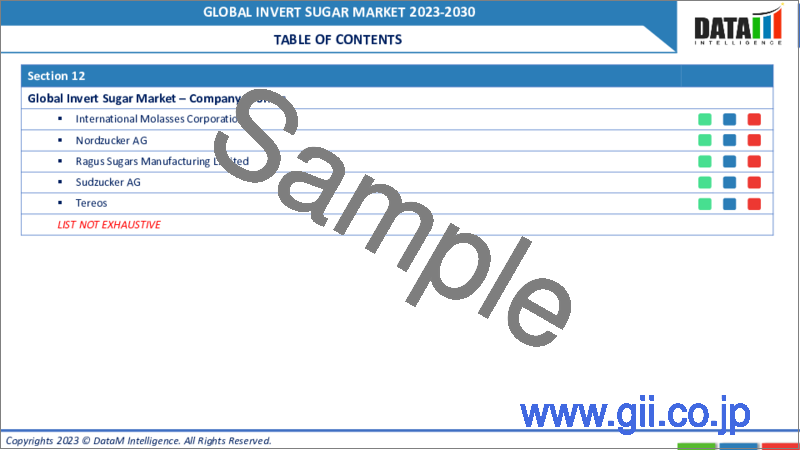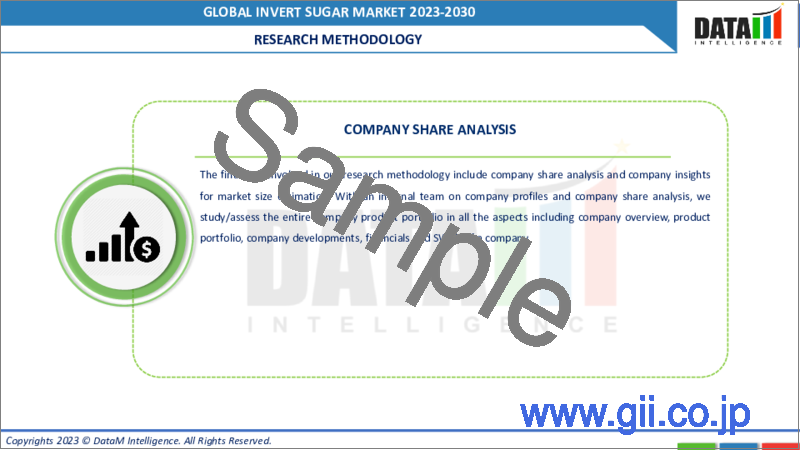|
|
市場調査レポート
商品コード
1319241
転化糖の世界市場-2023年~2030年Global Invert Sugar Market - 2023-2030 |
||||||
カスタマイズ可能
適宜更新あり
|
|||||||
| 転化糖の世界市場-2023年~2030年 |
|
出版日: 2023年07月31日
発行: DataM Intelligence
ページ情報: 英文 190 Pages
納期: 即日から翌営業日
|
- 全表示
- 概要
- 目次
市場概要
転化糖の世界市場は2022年に22億米ドルに達し、2023-2030年の予測期間中にCAGR 4.4%で成長し、2030年には31億米ドルに達すると予測されています。転化糖は食品産業で著しい成長を遂げており、その推進力となっているのは、転化糖が非常に人気の高い原料として位置づけられている複数の要因です。
この果糖とブドウ糖の混合物は消費者に好まれる調和のとれた甘味を提供し、様々な食品の味覚プロファイルを向上させ、これが世界の転化糖市場を牽引しています。転化糖の甘味度はショ糖の約1.3倍であるため、食品メーカーは砂糖の含有量を減らしながら好みの甘味度を実現することができ、健康志向の高まりに応えることができます。
転化糖の天然由来は、その人気上昇の大きな原動力となっています。果実や蜂蜜などの天然源に由来する転化糖は、自然で加工度の低い原材料を求める消費者の嗜好の高まりに見事に合致しています。この特性により転化糖は、人工甘味料に代わるものを求める健康志向の人々にとって魅力的な選択肢となっており、市場での存在感の拡大に寄与しています。
市場力学
加工食品と飲食品における利用の増加
加工食品および飲食品における転化糖の利用が急増しており、食品業界における転化糖の存在感を高めています。果糖とブドウ糖の混合物である転化糖は、加工食品および飲食品の配合に特有の要件に対応する独自の利点を提供します。加工食品や飲食品における転化糖の利用が増加しているのは、その高い甘味、天然由来、機能性成分としての多用途性に起因しています。
業界がより健康的な選択肢を優先し続け、消費者の嗜好が進化する中、転化糖は、幅広い加工食品や飲食品において、糖分含有量の削減、天然成分、製品品質の向上に対する需要を満たす貴重なソリューションを提供しています。例えば、2021年6月18日、ウクライナの農業・工業持株会社であるASTARTA社は、製品提供の範囲を拡大し、転化糖シロップの生産試験プログラムを開始しました。
多額の研究開発投資
転化糖の研究開発努力は、いくつかの主要分野に集中しています。転化糖の生産工程を強化することに重点を置き、効率の最適化、コスト削減、全体的な品質向上を目指しています。これには、転化糖の収量と純度を最大化するために、新技術を探求し、酸加水分解や酵素加水分解などの既存の転化糖製造法を改良することが含まれます。転化糖に関連する研究開発活動への多額の投資は、業界が転化糖の可能性を認識し、その市場成長を促進するために尽力していることを浮き彫りにしています。
継続的な研究、生産プロセスの革新、新たな用途や健康上の利点の探求を通じて、転化糖は有望な市場展望を持つ万能成分として支持を集め続けています。例えば、2020年2月6日、アルコール技術・バイオ燃料省は、転化糖は酵素加水分解または酸ベースの2つの技術によって製造されると宣言しました。
砂糖の大量消費別健康被害が製品需要を減少させる
砂糖の大量消費に伴う健康への悪影響は、市場における転化糖の需要減少につながっています。砂糖の過剰摂取がもたらす悪影響が科学的調査と社会的認識によって浮き彫りにされるにつれ、消費者は砂糖の消費量を減らし、健康リスクを軽減するのに役立つ代替品をますます求めるようになっています。
COVID-19影響分析
COVID-19分析には、COVID前シナリオ、COVIDシナリオ、COVID後シナリオが含まれ、価格力学(COVID前シナリオと比較したパンデミック中およびパンデミック後の価格変動を含む)、需給スペクトラム(取引制限、封鎖、およびその後の問題による需要と供給のシフト)、政府の取り組み(政府機関による市場、セクター、産業を活性化させる取り組み)、メーカーの戦略的取り組み(COVID問題を緩和するためにメーカーが行ったことをここで取り上げる)が含まれます。
人工知能分析
人工知能(AI)は、食品業界における転化糖の分析と理解において重要な役割を果たしています。高度なアルゴリズムとデータ分析技術を活用することにより、AIは膨大な量の情報を処理し、転化糖の特性、用途、市場需要に関する洞察を提供するパターンを特定することができます。AIは転化糖の化学組成、官能特性、および他の成分との相互作用を調べることによって、転化糖の分析に貢献することができます。機械学習アルゴリズムは転化糖と、風味プロファイル、食感の向上、保存期間の延長などの様々な要因との関係を特定することができます。この分析は、食品科学者や製造業者が配合を最適化し、さまざまな食品における転化糖の革新的な用途を開発するのに役立ちます。
目次
第1章 調査手法と調査範囲
第2章 市場の定義と概要
第3章 エグゼクティブサマリー
第4章 市場力学
- 市場への影響要因
- 促進要因
- 抑制要因
- 機会
- 影響分析
第5章 産業分析
- ポーターのファイブフォース分析
- サプライチェーン分析
- 価格分析
- 規制分析
第6章 COVID-19分析
第7章 タイプ別
- 完全転化糖
- 部分転化糖
第8章 用途別
- 飲食品
- 医薬品
- パーソナルケア
第9章 地域別
- 北米
- 米国
- カナダ
- メキシコ
- 欧州
- ドイツ
- 英国
- フランス
- イタリア
- スペイン
- その他欧州
- 南米
- ブラジル
- アルゼンチン
- その他南米
- アジア太平洋
- 中国
- インド
- 日本
- オーストラリア
- その他アジア太平洋地域
- 中東・アフリカ
第10章 競合情勢
- 競合シナリオ
- 市況/シェア分析
- M&A分析
第11章 企業プロファイル
- Archer Daniels Midland Company
- 会社概要
- 製品ポートフォリオと説明
- 財務概要
- 主な発展
- AP Multi Products Pvt. Ltd
- Cargill, Incorporated
- Eurosweet Gmbh
- Galam
- International Molasses Corporation
- Nordzucker AG
- Ragus Sugars Manufacturing Limited
- Sudzucker AG
- Tereos
第12章 付録
Market Overview
Global Invert Sugar Market reached US$ 2.2 billion in 2022 and is expected to reach US$ 3.1 billion by 2030 growing with a CAGR of 4.4% during the forecast period 2023-2030. Invert sugar is experiencing remarkable growth in the food industry, propelled by multiple factors that position it as a highly sought-after ingredient.
This fructose-glucose mixture delivers a harmonious sweetness preferred by consumers, enhancing the taste profiles of various food products which is driving the global invert sugar market. With its sweetness measuring approximately 1.3 times greater than sucrose, invert sugar allows food manufacturers to achieve desired levels of sweetness while reducing overall sugar content, catering to the increasing demand for healthier options.
The natural origin of invert sugar is a significant driving force behind its rising popularity. Derived from natural sources such as fruits and honey, it aligns perfectly with the growing consumer preference for ingredients that are natural and minimally processed. This attribute makes invert sugar an enticing choice for health-conscious individuals seeking alternatives to artificial sweeteners, contributing to its expanding market presence.
Market Dynamics
Increased Utilization in Processed Foods and Beverages
The utilization of inverted sugar in processed foods and beverages has witnessed a significant surge, driving its growing prominence in the food industry. As a fructose-glucose mixture, inverted sugar offers unique benefits that cater to the specific requirements of processed food and beverage formulations. The rise in the utilization of invert sugar in processed foods and beverages can be attributed to its high sweetness, natural origin, and versatility as a functional ingredient.
As the industry continues to prioritize healthier options and consumer preferences evolve, invert sugar offers a valuable solution to meet the demand for reduced sugar content, natural ingredients, and enhanced product quality in a wide array of processed foods and beverages. For instance, on June 18, 2021, ASTARTA, a Ukrainian agricultural and industrial holding company, has increased the scope of its product offerings and started a production-pilot programme for inverted sugar syrup.
Significant Research and Development Investments
The R&D efforts in invert sugar are focusing on several key areas. There is a strong emphasis on enhancing the production processes of inverted sugar, aiming to optimize efficiency, reduce costs, and improve overall quality. This involves exploring new technologies and refining existing methods of sucrose inversion, such as acid hydrolysis and enzymatic hydrolysis, to maximize the yield and purity of inverted sugar. The significant investments in R&D activities related to invert sugar highlight the industry's recognition of its potential and the commitment to driving its market growth.
Through ongoing research, innovations in production processes, and the exploration of new applications and health benefits, invert sugar continues to gain traction as a versatile ingredient with promising market prospects. For instance, on February 6, 2020, Department of Alcohol technology and Biofuels declared that the inverted is made via two technologies enzymatic hydrolysis or Acid based.
Health Consequences of High Sugar Consumption to Reduce Product Demand.
The detrimental health consequences associated with high sugar consumption have led to a reduction in the demand for invert sugar in the market. As scientific research and public awareness have highlighted the negative impacts of excessive sugar intake, consumers are increasingly seeking alternatives that can help reduce their sugar consumption and mitigate health risks.
COVID-19 Impact Analysis
The COVID-19 Analysis includes Pre-COVID Scenario, COVID Scenario and Post-COVID Scenario along with Pricing Dynamics (Including pricing change during and post-pandemic comparing it with pre-COVID scenarios), Demand-Supply Spectrum (Shift in demand and supply owing to trading restrictions, lockdown, and subsequent issues), Government Initiatives (Initiatives to revive market, sector or Industry by Government Bodies) and Manufacturers Strategic Initiatives (What manufacturers did to mitigate the COVID issues will be covered here).
Artificial Intelligence Analysis
Artificial intelligence (AI) plays a crucial role in the analysis and understanding of invert sugar in the food industry. By utilizing advanced algorithms and data analysis techniques, AI can process vast amounts of information and identify patterns that provide insights into the properties, applications, and market demand for invert sugar. AI can contribute to the analysis of invert sugar by examining its chemical composition, sensory characteristics, and interactions with other ingredients. Machine learning algorithms can identify relationships between invert sugar and various factors such as flavor profiles, texture enhancement, and shelf-life extension. This analysis helps food scientists and manufacturers optimize formulations and develop innovative applications for invert sugar in different food products.
Segment Analysis
The global invert sugar market is segmented based on type, application and region.
In the Global Market of Invert Sugar, the Fully Inverted Sugar Segment Holds the Largest Market Share
The fully inverted sugar segment is experiencing notable growth within the inverted sugar market. Fully inverted sugar, which results from the complete hydrolysis of sucrose into glucose and fructose, possesses distinctive qualities and advantages that are fueling its increasing demand. The key advantage is its high solubility, enabling effortless integration into various recipes and formulations. As a functional ingredient, fully inverted sugar enhances flavors, improves texture, and prolongs shelf life in a range of products, including confectioneries, baked goods, beverages, and dairy items. These qualities have propelled the expansion of the market for fully inverted sugar as it meets the needs of manufacturers and drives innovation within the food industry.
For instance, in 2022, Ragus Sugars Manufacturing Ltd. Published the process of fully inverted sugar. Water is heated to 70 degrees Celsius in large-scale inversion pans to produce fully inverted sugar syrup. When the sugar is saturated with sucrose, an acid is then added to lower the pH to 1.6. Sucrose breaks down, or inverts, into fructose and glucose as a result of these three factors: sugar saturation at 70 degrees Celsius and a pH of 1.7.
Geographical Analysis
Asia Pacific Held the Largest share in the Invert Sugar Market
The Asia Pacific region is witnessing rapid growth and emerging as the fastest-growing market in the inverted sugar industry. The increasing population and rising disposable incomes in countries across the Asia Pacific region are driving the inverted sugar market. The rising popularity of confectioneries, beverages, and processed foods has created a higher need for inverted sugar as a crucial component in these items.
Moreover, the growing utilization of inverted sugar as a functional ingredient in pharmaceutical products like syrups and injections is also playing a significant role in the region's expanding market dominance. For instance, on July 6, 2020, Sino Biopharmaceutical Limited. Voluntarily launched the "Invert Sugar Injection" a body fluid and energy supplement developed by the Group, has obtained approval for drug registration granted by the National Medical Products Administration of the People's Republic of China.
Competitive Landscape
The major global players in the market include: Archer Daniels Midland Company, AP Multi Products Pvt. Ltd, Cargill, Incorporated, Eurosweet Gmbh, Galam, International Molasses Corporation, Nordzucker AG, Ragus Sugars Manufacturing Limited, Sudzucker AG, and Tereos.
Why Purchase the Report?
- To visualize the global invert sugar market segmentation based on type, application, and region, as well as understand key commercial assets and players.
- Identify commercial opportunities in the market by analyzing trends and co-development.
- Excel data sheet with numerous data points of Invert Sugar market-level with all segments.
- The PDF report consists of cogently put-together market analysis after exhaustive qualitative interviews and in-depth market study.
- Product mapping is available as Excel consists of key products of all the major market players.
The global Invert Sugar market report would provide approximately 61 tables, 58 figures and 190 Pages.
Target Audience 2023
- Manufacturers/ Buyers
- Industry Investors/Investment Bankers
- Research Professionals
- Emerging Companies
Table of Contents
1. Methodology and Scope
- 1.1. Research Methodology
- 1.2. Research Objective and Scope of the Report
2. Market Definition and Overview
3. Executive Summary
- 3.1. Market Snippet, By Type
- 3.2. Market Snippet, By Application
- 3.3. Market Snippet, by Region
4. Market Dynamics
- 4.1. Market Impacting Factors
- 4.1.1. Drivers
- 4.1.2. Restraints
- 4.1.3. Opportunity
- 4.1.4. Impact Analysis
5. Industry Analysis
- 5.1. Porter's Five Force Analysis
- 5.2. Supply Chain Analysis
- 5.3. Pricing Analysis
- 5.4. Regulatory Analysis
6. COVID-19 Analysis
- 6.1. Analysis of COVID-19
- 6.1.1. Scenario Before COVID-19
- 6.1.2. Scenario During COVID-19
- 6.1.3. Scenario Post COVID-19
- 6.2. Pricing Dynamics Amid COVID-19
- 6.3. Demand-Supply Spectrum
- 6.4. Government Initiatives Related to the Market During Pandemic
- 6.5. Manufacturers Strategic Initiatives
- 6.6. Conclusion
7. By Type
- 7.1. Introduction
- 7.1.1. Market Size Analysis and Y-o-Y Growth Analysis (%), By Type
- 7.1.2. Market Attractiveness Index, By Type
- 7.2. Fully Inverted Sugar *
- 7.2.1. Introduction
- 7.2.2. Market Size Analysis and Y-o-Y Growth Analysis (%)
- 7.3. Partially Inverted Sugar
8. By Application
- 8.1. Introduction
- 8.1.1. Market Size Analysis and Y-o-Y Growth Analysis (%), By Application
- 8.1.2. Market Attractiveness Index, By Application
- 8.2. Food and Beverages*
- 8.2.1. Introduction
- 8.2.2. Market Size Analysis and Y-o-Y Growth Analysis (%)
- 8.3. Pharmaceuticals
- 8.4. Personal Care
9. By Region
- 9.1. Introduction
- 9.1.1. Market Size Analysis and Y-o-Y Growth Analysis (%), By Region
- 9.1.2. Market Attractiveness Index, By Region
- 9.2. North America*
- 9.2.1. Introduction
- 9.2.2. Key Region-Specific Dynamics
- 9.2.3. Market Size Analysis and Y-o-Y Growth Analysis (%), By Type
- 9.2.4. Market Size Analysis and Y-o-Y Growth Analysis (%), By Application
- 9.2.5. Market Size Analysis and Y-o-Y Growth Analysis (%), By Country
- 9.2.5.1. The U.S.
- 9.2.5.2. Canada
- 9.2.5.3. Mexico
- 9.3. Europe
- 9.3.1. Introduction
- 9.3.2. Key Region-Specific Dynamics
- 9.3.3. Market Size Analysis and Y-o-Y Growth Analysis (%), By Type
- 9.3.4. Market Size Analysis and Y-o-Y Growth Analysis (%), By Application
- 9.3.5. Market Size Analysis and Y-o-Y Growth Analysis (%), By Country
- 9.3.5.1. Germany
- 9.3.5.2. The U.K.
- 9.3.5.3. France
- 9.3.5.4. Italy
- 9.3.5.5. Spain
- 9.3.5.6. Rest of Europe
- 9.4. South America
- 9.4.1. Introduction
- 9.4.2. Key Region-Specific Dynamics
- 9.4.3. Market Size Analysis and Y-o-Y Growth Analysis (%), By Type
- 9.4.4. Market Size Analysis and Y-o-Y Growth Analysis (%), By Application
- 9.4.5. Market Size Analysis and Y-o-Y Growth Analysis (%), By Country
- 9.4.5.1. Brazil
- 9.4.5.2. Argentina
- 9.4.5.3. Rest of South America
- 9.5. Asia-Pacific
- 9.5.1. Introduction
- 9.5.2. Key Region-Specific Dynamics
- 9.5.3. Market Size Analysis and Y-o-Y Growth Analysis (%), By Type
- 9.5.4. Market Size Analysis and Y-o-Y Growth Analysis (%), By Application
- 9.5.5. Market Size Analysis and Y-o-Y Growth Analysis (%), By Country
- 9.5.5.1. China
- 9.5.5.2. India
- 9.5.5.3. Japan
- 9.5.5.4. Australia
- 9.5.5.5. Rest of Asia-Pacific
- 9.6. Middle East and Africa
- 9.6.1. Introduction
- 9.6.2. Key Region-Specific Dynamics
- 9.6.3. Market Size Analysis and Y-o-Y Growth Analysis (%), By Type
- 9.6.4. Market Size Analysis and Y-o-Y Growth Analysis (%), By Application
10. Competitive Landscape
- 10.1. Competitive Scenario
- 10.2. Market Positioning/Share Analysis
- 10.3. Mergers and Acquisitions Analysis
11. Company Profiles
- 11.1. Archer Daniels Midland Company
- 11.1.1. Company Overview
- 11.1.2. Product Portfolio and Description
- 11.1.3. Financial Overview
- 11.1.4. Key Developments
- 11.2. AP Multi Products Pvt. Ltd
- 11.3. Cargill, Incorporated
- 11.4. Eurosweet Gmbh
- 11.5. Galam
- 11.6. International Molasses Corporation
- 11.7. Nordzucker AG
- 11.8. Ragus Sugars Manufacturing Limited
- 11.9. Sudzucker AG
- 11.10. Tereos
LIST NOT EXHAUSTIVE
12. Appendix
- 12.1. About Us and Services
- 12.2. Contact Us






